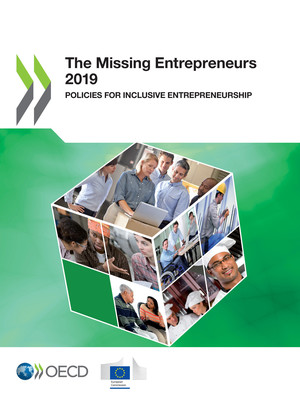copy the linklink copied!21. Greece
This country profile benchmarks key self-employment and entrepreneurship data for women, youth, seniors and immigrants against the European Union average. It also highlights current inclusive entrepreneurship policy issues and recent developments in Greece.
copy the linklink copied!Key trends
Nearly one-third of working Greeks were self-employed in 2018 (29.1%), which was more than double the European Union (EU) average (13.5%). This was also observed across most of the key target groups: women (22.9% vs. 9.6%), youth (12.6% vs. 6.5%) and seniors (41.8% vs. 17.7%). However, the self-employment rate for immigrants was below the EU average (6.8% vs. 8.0%). The self-employed were slightly less likely than the EU average to have employees. However, very few early-stage entrepreneurs expected to create at least 19 jobs over the next five years. Only 1.3% of new women entrepreneurs, 3.8% of new youth entrepreneurs and 4.2% of senior entrepreneurs reported this level of expected job creation between 2014 and 2018.
copy the linklink copied!Hot issue
The effects of the economic crisis and bailouts continue to linger. Entrepreneurship policy increasingly focuses on strengthening the entrepreneurship ecosystem, innovative start-ups and graduate entrepreneurs. The European Commission’s third post-bailout assessment was published in June 2019 and it highlights several positive developments, including increased acceptance of payment cards by very small businesses and improvements in the regulatory environment that boost economic activity such as allowing small businesses to open on Sundays in the peak tourism season (May to October).
copy the linklink copied!Recent policy developments
A recent development is the introduction by the Ministry of Economy, Development and Tourism of the Support of self-employment graduates of higher education (B' Cycle) measure (Ενίσχυση της αυτοαπασχόλησης Πτυχιούχων Τριτοβάθμιας Εκπαίδευσης [Β' Κύκλος]) in 2017. The measure supports the business creation by unemployed graduates as well as already self-employed graduates with grants of EUR 5 000 to EUR 25 000. The measure aims at creating new jobs and is co-financed by the European Social Fund and the national government.
This profile is based on a recent country assessment report, which can be found at: www.oecd.org/cfe/leed/inclusive-entrepreneurship.htm.
Metadata, Legal and Rights
https://doi.org/10.1787/3ed84801-en
© OECD/European Union 2019
The use of this work, whether digital or print, is governed by the Terms and Conditions to be found at http://www.oecd.org/termsandconditions.



